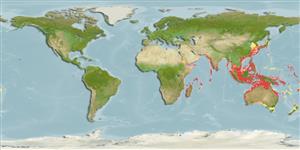>
Pleuronectiformes (Flatfishes) >
Soleidae (Soles)
Etymology: Aesopia: Term related to Latin fabulae; Quintilian recognized the existence of the Aesopia as "beast fable"..
More on author: Kaup.
Environment: milieu / climate zone / depth range / distribution range
Ecología
marino asociado a arrecife; rango de profundidad 8 - 100 m (Ref. 9710). Tropical
Indo-West Pacific: Red Sea, Mozambique, South Africa, India and Japan. Reported from Indonesia and northwestern Australia (Ref. 5978).
Tamaño / Peso / Age
Maturity: Lm ? range ? - ? cm
Max length : 25.0 cm SL macho / no sexado; (Ref. 48637)
Espinas dorsales (total): 0; Radios blandos dorsales (total): 69-79; Espinas anales 0; Radios blandos anales: 59 - 66; Vértebra: 46. Greyish or brown, with 15-16 dark bars edged with black (the first 3 bars on head); caudal fin blackish with pale spots (Ref. 3200).
Found in coastal waters (Ref. 30573), on sand or mud bottoms to at least 100 m (Ref. 9710, 11230, 48637).
Life cycle and mating behavior
Madurez | Reproducción | Puesta | Huevos | Fecundidad | Larva
Heemstra, P.C. and O. Gon, 1986. Soleidae. p. 868-874. In M.M. Smith and P.C. Heemstra (eds.) Smiths' sea fishes. Springer-Verlag, Berlin. (Ref. 3200)
IUCN Red List Status (Ref. 130435)
Threat to humans
Harmless
Human uses
Pesquerías: comercial
Más información
Nombres comunesSinónimosMetabolismoDespredadoresEcotoxicologíaReproducciónMadurezPuestaAgregación para la puestaFecundidadHuevosEgg development
ReferenciasAcuiculturaPerfil de acuiculturaRazasGenéticaElectrophoresesheritabilidadEnfermedadesProcesamientoNutrientsMass conversion
Herramientas
Special reports
Download XML
Fuentes de Internet
Estimates based on models
Preferred temperature (Ref.
123201): 23.3 - 29.1, mean 28 °C (based on 1750 cells).
Phylogenetic diversity index (Ref.
82804): PD
50 = 1.0000 [Uniqueness, from 0.5 = low to 2.0 = high].
Bayesian length-weight: a=0.00977 (0.00473 - 0.02021), b=3.07 (2.90 - 3.24), in cm total length, based on LWR estimates for this (Sub)family-body shape (Ref.
93245).
Nivel trófico (Ref.
69278): 3.5 ±0.4 se; based on size and trophs of closest relatives
Resiliencia (Ref.
120179): Medio, población duplicada en un tiempo mínimo de 1.4-4.4 años (Preliminary K or Fecundity.).
Fishing Vulnerability (Ref.
59153): Low vulnerability (21 of 100).
Nutrients (Ref.
124155): Calcium = 62.8 [23.4, 219.9] mg/100g; Iron = 0.553 [0.235, 1.098] mg/100g; Protein = 18.3 [16.3, 20.3] %; Omega3 = 0.0737 [, ] g/100g; Selenium = 34.1 [16.8, 71.4] μg/100g; VitaminA = 69.8 [18.0, 275.8] μg/100g; Zinc = 1.15 [0.70, 1.68] mg/100g (wet weight);
